Clinical Nursing: Diagnosis and Treatment of Acute Respiratory Distress Syndrome
VerifiedAdded on 2022/11/14
|8
|2430
|329
AI Summary
This clinical nursing case study discusses the diagnosis and treatment of Acute Respiratory Distress Syndrome (ARDS) in a patient with Multiple Systems Atrophy. It covers the patient's background, past medical history, aetiology and pathophysiology of ARDS, physical examination, and one pharmacological treatment option for ARDS. The study also includes expected findings based on the condition.
Contribute Materials
Your contribution can guide someone’s learning journey. Share your
documents today.

Running head: CLINICAL NURSING
Clinical Nursing
Name
Institution
Clinical Nursing
Name
Institution
Secure Best Marks with AI Grader
Need help grading? Try our AI Grader for instant feedback on your assignments.
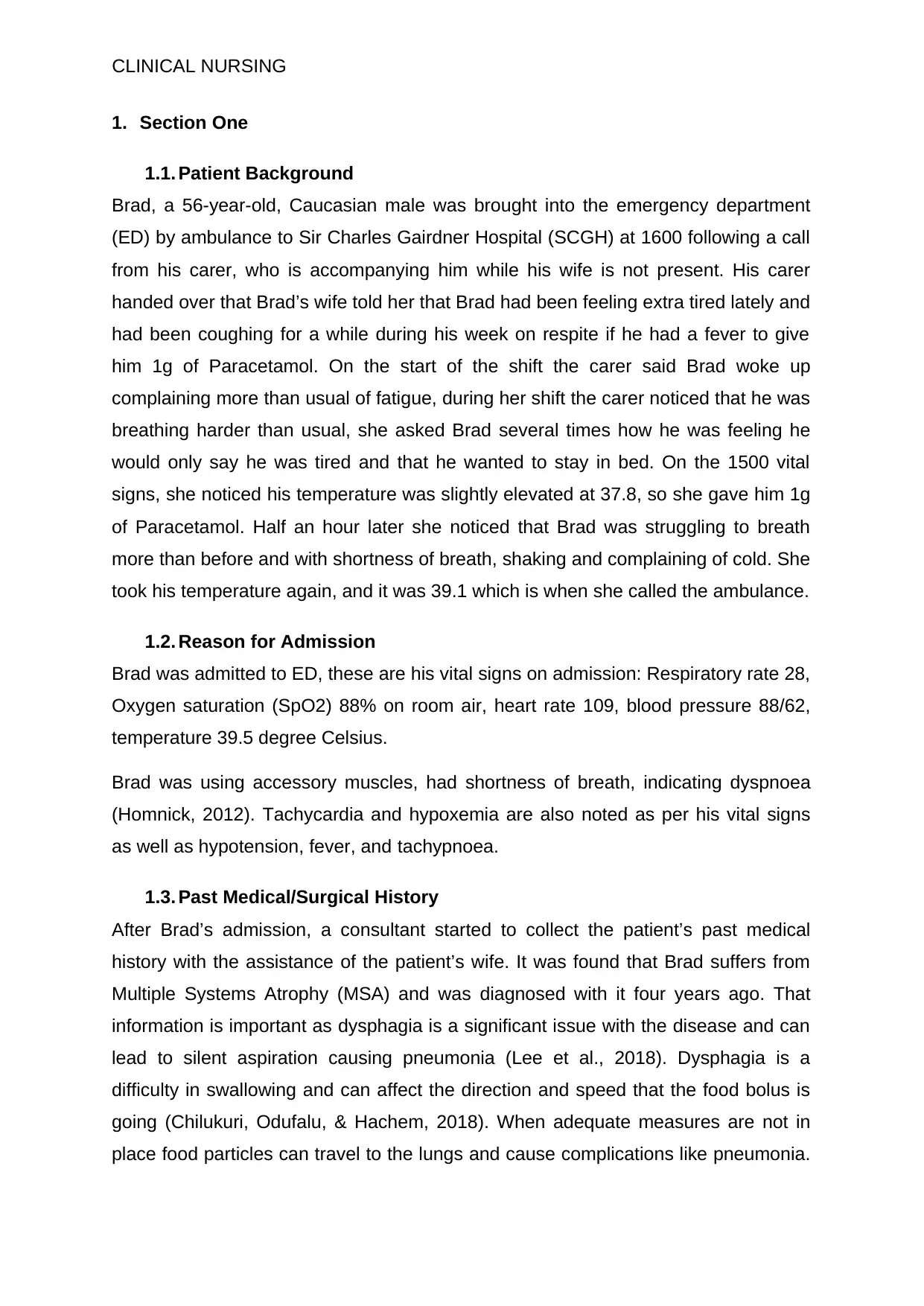
CLINICAL NURSING
1. Section One
1.1. Patient Background
Brad, a 56-year-old, Caucasian male was brought into the emergency department
(ED) by ambulance to Sir Charles Gairdner Hospital (SCGH) at 1600 following a call
from his carer, who is accompanying him while his wife is not present. His carer
handed over that Brad’s wife told her that Brad had been feeling extra tired lately and
had been coughing for a while during his week on respite if he had a fever to give
him 1g of Paracetamol. On the start of the shift the carer said Brad woke up
complaining more than usual of fatigue, during her shift the carer noticed that he was
breathing harder than usual, she asked Brad several times how he was feeling he
would only say he was tired and that he wanted to stay in bed. On the 1500 vital
signs, she noticed his temperature was slightly elevated at 37.8, so she gave him 1g
of Paracetamol. Half an hour later she noticed that Brad was struggling to breath
more than before and with shortness of breath, shaking and complaining of cold. She
took his temperature again, and it was 39.1 which is when she called the ambulance.
1.2. Reason for Admission
Brad was admitted to ED, these are his vital signs on admission: Respiratory rate 28,
Oxygen saturation (SpO2) 88% on room air, heart rate 109, blood pressure 88/62,
temperature 39.5 degree Celsius.
Brad was using accessory muscles, had shortness of breath, indicating dyspnoea
(Homnick, 2012). Tachycardia and hypoxemia are also noted as per his vital signs
as well as hypotension, fever, and tachypnoea.
1.3. Past Medical/Surgical History
After Brad’s admission, a consultant started to collect the patient’s past medical
history with the assistance of the patient’s wife. It was found that Brad suffers from
Multiple Systems Atrophy (MSA) and was diagnosed with it four years ago. That
information is important as dysphagia is a significant issue with the disease and can
lead to silent aspiration causing pneumonia (Lee et al., 2018). Dysphagia is a
difficulty in swallowing and can affect the direction and speed that the food bolus is
going (Chilukuri, Odufalu, & Hachem, 2018). When adequate measures are not in
place food particles can travel to the lungs and cause complications like pneumonia.
1. Section One
1.1. Patient Background
Brad, a 56-year-old, Caucasian male was brought into the emergency department
(ED) by ambulance to Sir Charles Gairdner Hospital (SCGH) at 1600 following a call
from his carer, who is accompanying him while his wife is not present. His carer
handed over that Brad’s wife told her that Brad had been feeling extra tired lately and
had been coughing for a while during his week on respite if he had a fever to give
him 1g of Paracetamol. On the start of the shift the carer said Brad woke up
complaining more than usual of fatigue, during her shift the carer noticed that he was
breathing harder than usual, she asked Brad several times how he was feeling he
would only say he was tired and that he wanted to stay in bed. On the 1500 vital
signs, she noticed his temperature was slightly elevated at 37.8, so she gave him 1g
of Paracetamol. Half an hour later she noticed that Brad was struggling to breath
more than before and with shortness of breath, shaking and complaining of cold. She
took his temperature again, and it was 39.1 which is when she called the ambulance.
1.2. Reason for Admission
Brad was admitted to ED, these are his vital signs on admission: Respiratory rate 28,
Oxygen saturation (SpO2) 88% on room air, heart rate 109, blood pressure 88/62,
temperature 39.5 degree Celsius.
Brad was using accessory muscles, had shortness of breath, indicating dyspnoea
(Homnick, 2012). Tachycardia and hypoxemia are also noted as per his vital signs
as well as hypotension, fever, and tachypnoea.
1.3. Past Medical/Surgical History
After Brad’s admission, a consultant started to collect the patient’s past medical
history with the assistance of the patient’s wife. It was found that Brad suffers from
Multiple Systems Atrophy (MSA) and was diagnosed with it four years ago. That
information is important as dysphagia is a significant issue with the disease and can
lead to silent aspiration causing pneumonia (Lee et al., 2018). Dysphagia is a
difficulty in swallowing and can affect the direction and speed that the food bolus is
going (Chilukuri, Odufalu, & Hachem, 2018). When adequate measures are not in
place food particles can travel to the lungs and cause complications like pneumonia.
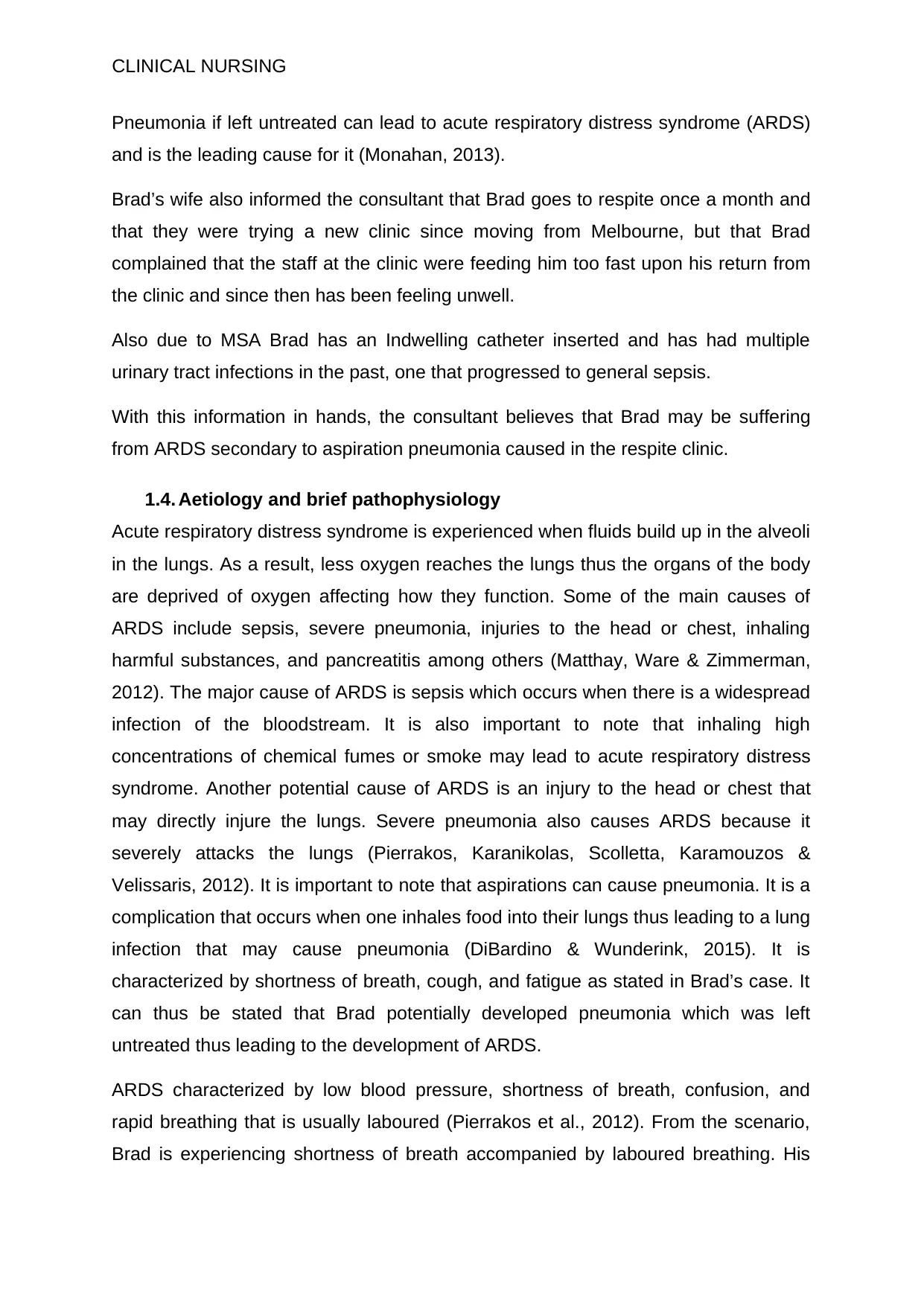
CLINICAL NURSING
Pneumonia if left untreated can lead to acute respiratory distress syndrome (ARDS)
and is the leading cause for it (Monahan, 2013).
Brad’s wife also informed the consultant that Brad goes to respite once a month and
that they were trying a new clinic since moving from Melbourne, but that Brad
complained that the staff at the clinic were feeding him too fast upon his return from
the clinic and since then has been feeling unwell.
Also due to MSA Brad has an Indwelling catheter inserted and has had multiple
urinary tract infections in the past, one that progressed to general sepsis.
With this information in hands, the consultant believes that Brad may be suffering
from ARDS secondary to aspiration pneumonia caused in the respite clinic.
1.4. Aetiology and brief pathophysiology
Acute respiratory distress syndrome is experienced when fluids build up in the alveoli
in the lungs. As a result, less oxygen reaches the lungs thus the organs of the body
are deprived of oxygen affecting how they function. Some of the main causes of
ARDS include sepsis, severe pneumonia, injuries to the head or chest, inhaling
harmful substances, and pancreatitis among others (Matthay, Ware & Zimmerman,
2012). The major cause of ARDS is sepsis which occurs when there is a widespread
infection of the bloodstream. It is also important to note that inhaling high
concentrations of chemical fumes or smoke may lead to acute respiratory distress
syndrome. Another potential cause of ARDS is an injury to the head or chest that
may directly injure the lungs. Severe pneumonia also causes ARDS because it
severely attacks the lungs (Pierrakos, Karanikolas, Scolletta, Karamouzos &
Velissaris, 2012). It is important to note that aspirations can cause pneumonia. It is a
complication that occurs when one inhales food into their lungs thus leading to a lung
infection that may cause pneumonia (DiBardino & Wunderink, 2015). It is
characterized by shortness of breath, cough, and fatigue as stated in Brad’s case. It
can thus be stated that Brad potentially developed pneumonia which was left
untreated thus leading to the development of ARDS.
ARDS characterized by low blood pressure, shortness of breath, confusion, and
rapid breathing that is usually laboured (Pierrakos et al., 2012). From the scenario,
Brad is experiencing shortness of breath accompanied by laboured breathing. His
Pneumonia if left untreated can lead to acute respiratory distress syndrome (ARDS)
and is the leading cause for it (Monahan, 2013).
Brad’s wife also informed the consultant that Brad goes to respite once a month and
that they were trying a new clinic since moving from Melbourne, but that Brad
complained that the staff at the clinic were feeding him too fast upon his return from
the clinic and since then has been feeling unwell.
Also due to MSA Brad has an Indwelling catheter inserted and has had multiple
urinary tract infections in the past, one that progressed to general sepsis.
With this information in hands, the consultant believes that Brad may be suffering
from ARDS secondary to aspiration pneumonia caused in the respite clinic.
1.4. Aetiology and brief pathophysiology
Acute respiratory distress syndrome is experienced when fluids build up in the alveoli
in the lungs. As a result, less oxygen reaches the lungs thus the organs of the body
are deprived of oxygen affecting how they function. Some of the main causes of
ARDS include sepsis, severe pneumonia, injuries to the head or chest, inhaling
harmful substances, and pancreatitis among others (Matthay, Ware & Zimmerman,
2012). The major cause of ARDS is sepsis which occurs when there is a widespread
infection of the bloodstream. It is also important to note that inhaling high
concentrations of chemical fumes or smoke may lead to acute respiratory distress
syndrome. Another potential cause of ARDS is an injury to the head or chest that
may directly injure the lungs. Severe pneumonia also causes ARDS because it
severely attacks the lungs (Pierrakos, Karanikolas, Scolletta, Karamouzos &
Velissaris, 2012). It is important to note that aspirations can cause pneumonia. It is a
complication that occurs when one inhales food into their lungs thus leading to a lung
infection that may cause pneumonia (DiBardino & Wunderink, 2015). It is
characterized by shortness of breath, cough, and fatigue as stated in Brad’s case. It
can thus be stated that Brad potentially developed pneumonia which was left
untreated thus leading to the development of ARDS.
ARDS characterized by low blood pressure, shortness of breath, confusion, and
rapid breathing that is usually laboured (Pierrakos et al., 2012). From the scenario,
Brad is experiencing shortness of breath accompanied by laboured breathing. His
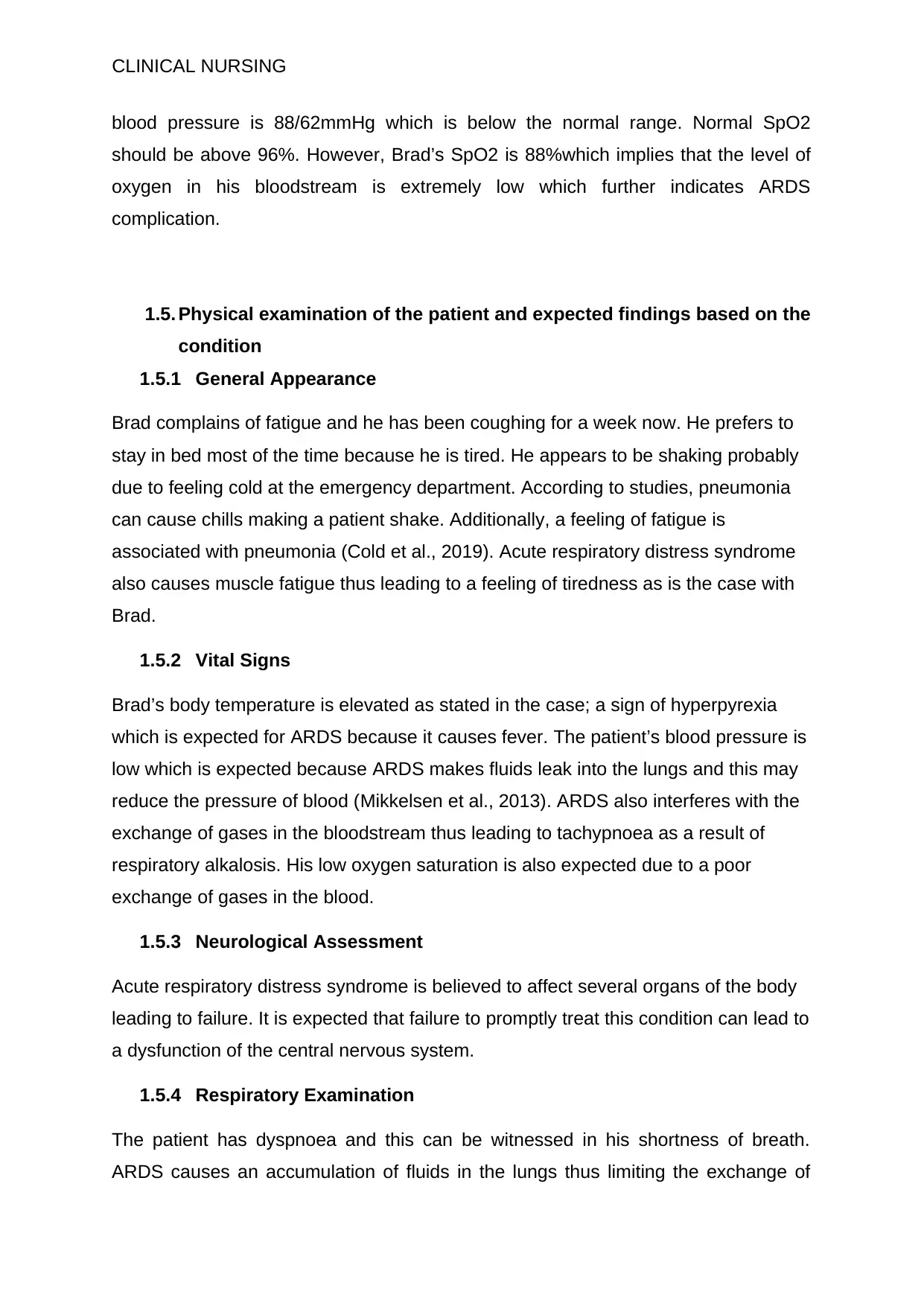
CLINICAL NURSING
blood pressure is 88/62mmHg which is below the normal range. Normal SpO2
should be above 96%. However, Brad’s SpO2 is 88%which implies that the level of
oxygen in his bloodstream is extremely low which further indicates ARDS
complication.
1.5. Physical examination of the patient and expected findings based on the
condition
1.5.1 General Appearance
Brad complains of fatigue and he has been coughing for a week now. He prefers to
stay in bed most of the time because he is tired. He appears to be shaking probably
due to feeling cold at the emergency department. According to studies, pneumonia
can cause chills making a patient shake. Additionally, a feeling of fatigue is
associated with pneumonia (Cold et al., 2019). Acute respiratory distress syndrome
also causes muscle fatigue thus leading to a feeling of tiredness as is the case with
Brad.
1.5.2 Vital Signs
Brad’s body temperature is elevated as stated in the case; a sign of hyperpyrexia
which is expected for ARDS because it causes fever. The patient’s blood pressure is
low which is expected because ARDS makes fluids leak into the lungs and this may
reduce the pressure of blood (Mikkelsen et al., 2013). ARDS also interferes with the
exchange of gases in the bloodstream thus leading to tachypnoea as a result of
respiratory alkalosis. His low oxygen saturation is also expected due to a poor
exchange of gases in the blood.
1.5.3 Neurological Assessment
Acute respiratory distress syndrome is believed to affect several organs of the body
leading to failure. It is expected that failure to promptly treat this condition can lead to
a dysfunction of the central nervous system.
1.5.4 Respiratory Examination
The patient has dyspnoea and this can be witnessed in his shortness of breath.
ARDS causes an accumulation of fluids in the lungs thus limiting the exchange of
blood pressure is 88/62mmHg which is below the normal range. Normal SpO2
should be above 96%. However, Brad’s SpO2 is 88%which implies that the level of
oxygen in his bloodstream is extremely low which further indicates ARDS
complication.
1.5. Physical examination of the patient and expected findings based on the
condition
1.5.1 General Appearance
Brad complains of fatigue and he has been coughing for a week now. He prefers to
stay in bed most of the time because he is tired. He appears to be shaking probably
due to feeling cold at the emergency department. According to studies, pneumonia
can cause chills making a patient shake. Additionally, a feeling of fatigue is
associated with pneumonia (Cold et al., 2019). Acute respiratory distress syndrome
also causes muscle fatigue thus leading to a feeling of tiredness as is the case with
Brad.
1.5.2 Vital Signs
Brad’s body temperature is elevated as stated in the case; a sign of hyperpyrexia
which is expected for ARDS because it causes fever. The patient’s blood pressure is
low which is expected because ARDS makes fluids leak into the lungs and this may
reduce the pressure of blood (Mikkelsen et al., 2013). ARDS also interferes with the
exchange of gases in the bloodstream thus leading to tachypnoea as a result of
respiratory alkalosis. His low oxygen saturation is also expected due to a poor
exchange of gases in the blood.
1.5.3 Neurological Assessment
Acute respiratory distress syndrome is believed to affect several organs of the body
leading to failure. It is expected that failure to promptly treat this condition can lead to
a dysfunction of the central nervous system.
1.5.4 Respiratory Examination
The patient has dyspnoea and this can be witnessed in his shortness of breath.
ARDS causes an accumulation of fluids in the lungs thus limiting the exchange of
Secure Best Marks with AI Grader
Need help grading? Try our AI Grader for instant feedback on your assignments.

CLINICAL NURSING
gases in the bloodstream (Homnick, 2012). He has also been coughing for a week
which is expected because ARDS causes a tightness of chest thus leading to
persistent coughs.
1.5.5 Cardiovascular Examination
On performing heart auscultation, it is established that Brad’s heart rate is 109bpm.
Tachycardia is a common feature of ARDS because the organs of the body are
depleted of blood rich in oxygen and thus the heart pumps blood faster to try and
compensate for this insufficiency (Pierrakos et al., 2012).
1.5.6 Extremities
Examining the extremities may reveal cool extremities as a result of poor perfusion
which occurs in ARDS (Pierrakos et al., 2012). Peripheral cyanosis is also expected
in acute respiratory distress syndrome due to the low concentration of oxygen in the
red blood cells.
2.0 Section 2
2.1 Critique in detail one treatment for the diagnosis
Patients suffering from acute respiratory distress syndrome normally require
immediate care because this condition is usually life-threatening. This condition is
characterised by insufficient oxygen in the blood and lungs (Muideen Adigun, 2019).
Some of the risk factors that are associated with acute respiratory distress syndrome
include sepsis, trauma, and pneumonia; like in Brad’s case. There is no single
pharmacological treatment for ARDS but instead, health practitioners use supportive
care in combination with agents such as neuromuscular blocking agents and
corticosteroids. The main focus of the pharmacological treatment of ARDS is to treat
the primary cause of an injury to the lungs (Force, Ranieri & Rubenfeld, 2012). A
pharmacological intervention helps in maintaining sufficient oxygenation and thus
helping to reduce mortality and morbidity.
One of the most reasonable pharmacological treatment options for ARDS is
prednisone due to its non-inflammatory properties. This medication belongs to a
group of corticosteroids that perform their anti-inflammatory properties either in a
genomic or non-genomic way. Prednisone uses two genomic anti-inflammatory
mechanisms that include transactivation and trans-repression (Rezk & Ibrahim,
gases in the bloodstream (Homnick, 2012). He has also been coughing for a week
which is expected because ARDS causes a tightness of chest thus leading to
persistent coughs.
1.5.5 Cardiovascular Examination
On performing heart auscultation, it is established that Brad’s heart rate is 109bpm.
Tachycardia is a common feature of ARDS because the organs of the body are
depleted of blood rich in oxygen and thus the heart pumps blood faster to try and
compensate for this insufficiency (Pierrakos et al., 2012).
1.5.6 Extremities
Examining the extremities may reveal cool extremities as a result of poor perfusion
which occurs in ARDS (Pierrakos et al., 2012). Peripheral cyanosis is also expected
in acute respiratory distress syndrome due to the low concentration of oxygen in the
red blood cells.
2.0 Section 2
2.1 Critique in detail one treatment for the diagnosis
Patients suffering from acute respiratory distress syndrome normally require
immediate care because this condition is usually life-threatening. This condition is
characterised by insufficient oxygen in the blood and lungs (Muideen Adigun, 2019).
Some of the risk factors that are associated with acute respiratory distress syndrome
include sepsis, trauma, and pneumonia; like in Brad’s case. There is no single
pharmacological treatment for ARDS but instead, health practitioners use supportive
care in combination with agents such as neuromuscular blocking agents and
corticosteroids. The main focus of the pharmacological treatment of ARDS is to treat
the primary cause of an injury to the lungs (Force, Ranieri & Rubenfeld, 2012). A
pharmacological intervention helps in maintaining sufficient oxygenation and thus
helping to reduce mortality and morbidity.
One of the most reasonable pharmacological treatment options for ARDS is
prednisone due to its non-inflammatory properties. This medication belongs to a
group of corticosteroids that perform their anti-inflammatory properties either in a
genomic or non-genomic way. Prednisone uses two genomic anti-inflammatory
mechanisms that include transactivation and trans-repression (Rezk & Ibrahim,
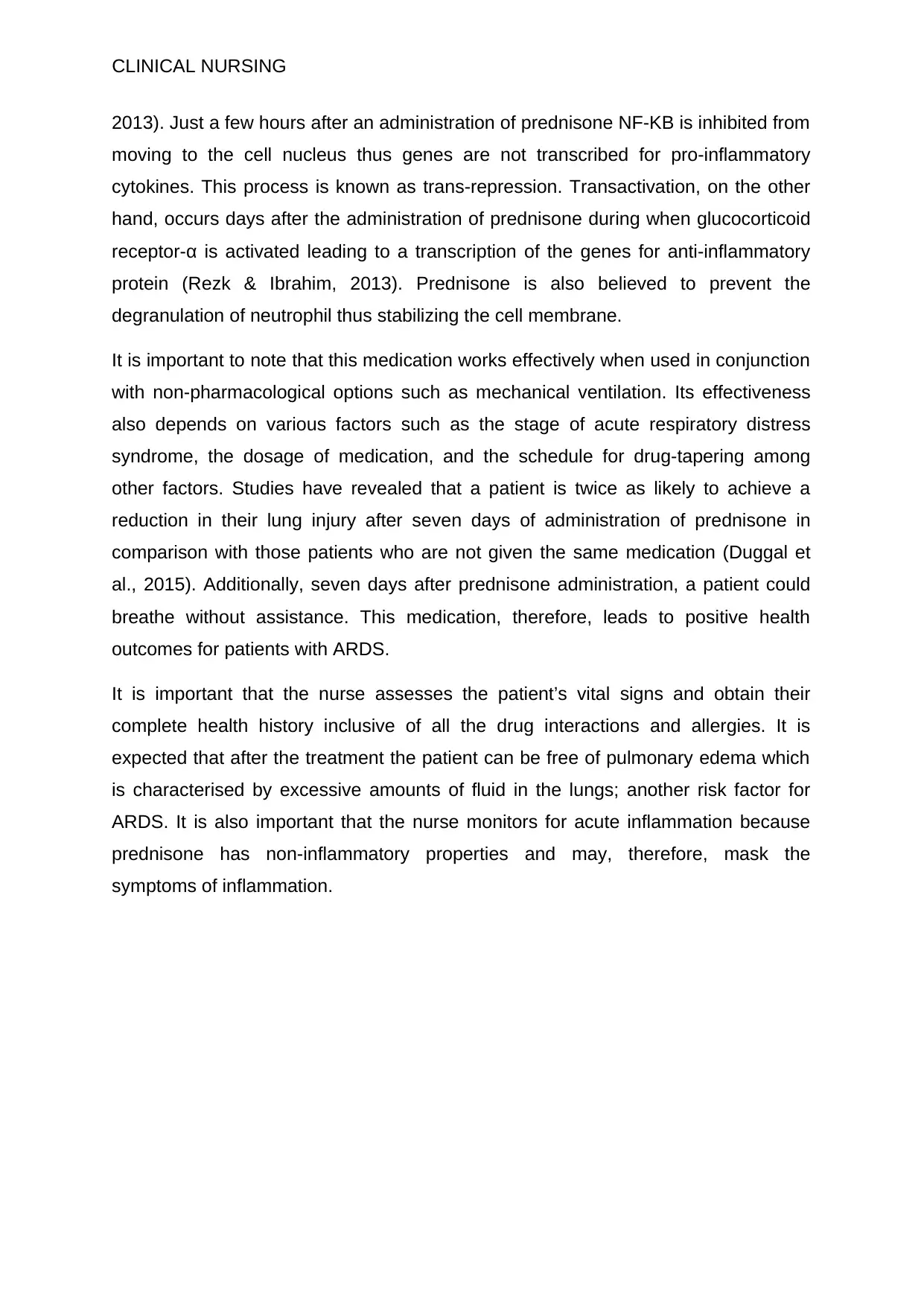
CLINICAL NURSING
2013). Just a few hours after an administration of prednisone NF-KB is inhibited from
moving to the cell nucleus thus genes are not transcribed for pro-inflammatory
cytokines. This process is known as trans-repression. Transactivation, on the other
hand, occurs days after the administration of prednisone during when glucocorticoid
receptor-α is activated leading to a transcription of the genes for anti-inflammatory
protein (Rezk & Ibrahim, 2013). Prednisone is also believed to prevent the
degranulation of neutrophil thus stabilizing the cell membrane.
It is important to note that this medication works effectively when used in conjunction
with non-pharmacological options such as mechanical ventilation. Its effectiveness
also depends on various factors such as the stage of acute respiratory distress
syndrome, the dosage of medication, and the schedule for drug-tapering among
other factors. Studies have revealed that a patient is twice as likely to achieve a
reduction in their lung injury after seven days of administration of prednisone in
comparison with those patients who are not given the same medication (Duggal et
al., 2015). Additionally, seven days after prednisone administration, a patient could
breathe without assistance. This medication, therefore, leads to positive health
outcomes for patients with ARDS.
It is important that the nurse assesses the patient’s vital signs and obtain their
complete health history inclusive of all the drug interactions and allergies. It is
expected that after the treatment the patient can be free of pulmonary edema which
is characterised by excessive amounts of fluid in the lungs; another risk factor for
ARDS. It is also important that the nurse monitors for acute inflammation because
prednisone has non-inflammatory properties and may, therefore, mask the
symptoms of inflammation.
2013). Just a few hours after an administration of prednisone NF-KB is inhibited from
moving to the cell nucleus thus genes are not transcribed for pro-inflammatory
cytokines. This process is known as trans-repression. Transactivation, on the other
hand, occurs days after the administration of prednisone during when glucocorticoid
receptor-α is activated leading to a transcription of the genes for anti-inflammatory
protein (Rezk & Ibrahim, 2013). Prednisone is also believed to prevent the
degranulation of neutrophil thus stabilizing the cell membrane.
It is important to note that this medication works effectively when used in conjunction
with non-pharmacological options such as mechanical ventilation. Its effectiveness
also depends on various factors such as the stage of acute respiratory distress
syndrome, the dosage of medication, and the schedule for drug-tapering among
other factors. Studies have revealed that a patient is twice as likely to achieve a
reduction in their lung injury after seven days of administration of prednisone in
comparison with those patients who are not given the same medication (Duggal et
al., 2015). Additionally, seven days after prednisone administration, a patient could
breathe without assistance. This medication, therefore, leads to positive health
outcomes for patients with ARDS.
It is important that the nurse assesses the patient’s vital signs and obtain their
complete health history inclusive of all the drug interactions and allergies. It is
expected that after the treatment the patient can be free of pulmonary edema which
is characterised by excessive amounts of fluid in the lungs; another risk factor for
ARDS. It is also important that the nurse monitors for acute inflammation because
prednisone has non-inflammatory properties and may, therefore, mask the
symptoms of inflammation.
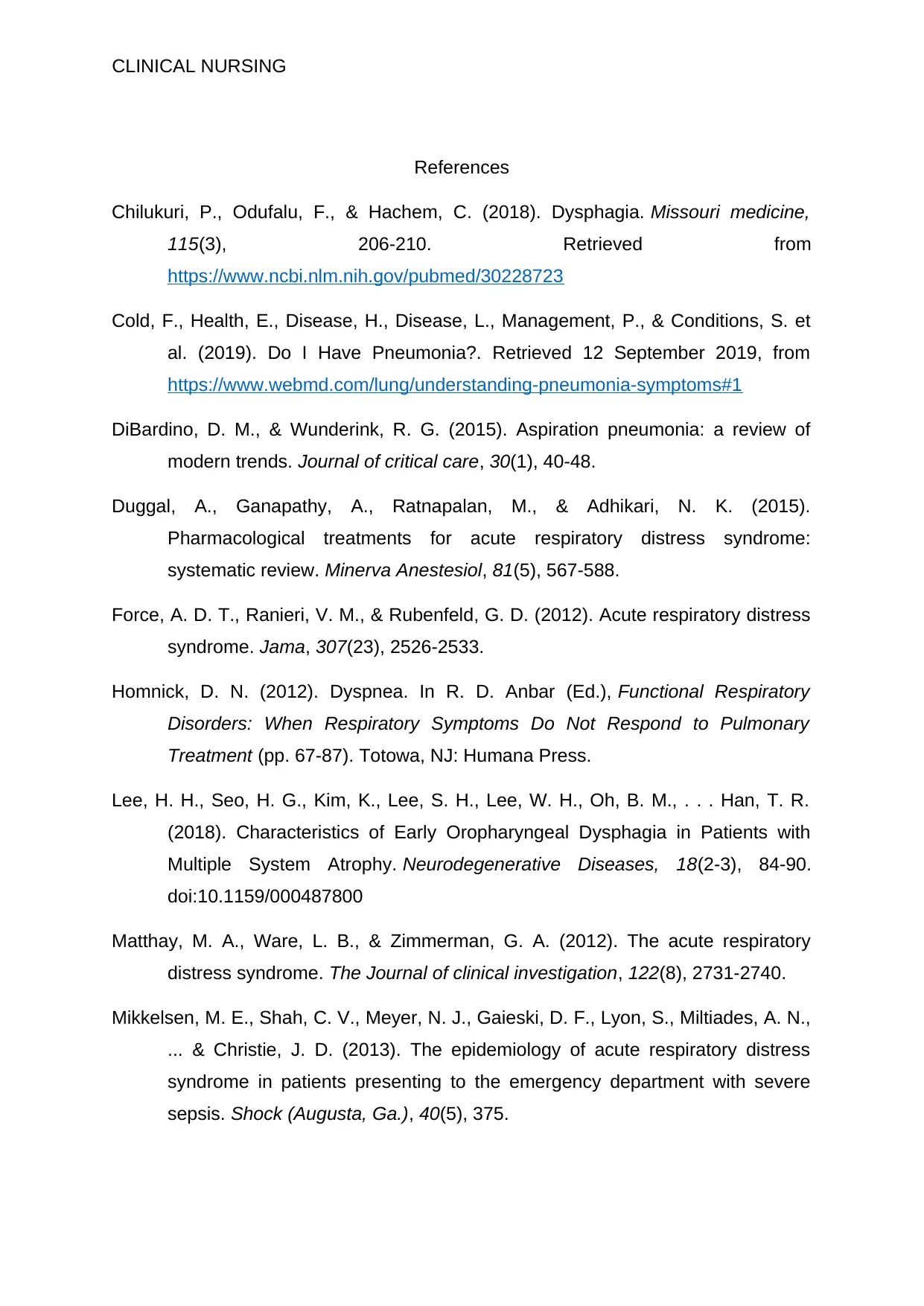
CLINICAL NURSING
References
Chilukuri, P., Odufalu, F., & Hachem, C. (2018). Dysphagia. Missouri medicine,
115(3), 206-210. Retrieved from
https://www.ncbi.nlm.nih.gov/pubmed/30228723
Cold, F., Health, E., Disease, H., Disease, L., Management, P., & Conditions, S. et
al. (2019). Do I Have Pneumonia?. Retrieved 12 September 2019, from
https://www.webmd.com/lung/understanding-pneumonia-symptoms#1
DiBardino, D. M., & Wunderink, R. G. (2015). Aspiration pneumonia: a review of
modern trends. Journal of critical care, 30(1), 40-48.
Duggal, A., Ganapathy, A., Ratnapalan, M., & Adhikari, N. K. (2015).
Pharmacological treatments for acute respiratory distress syndrome:
systematic review. Minerva Anestesiol, 81(5), 567-588.
Force, A. D. T., Ranieri, V. M., & Rubenfeld, G. D. (2012). Acute respiratory distress
syndrome. Jama, 307(23), 2526-2533.
Homnick, D. N. (2012). Dyspnea. In R. D. Anbar (Ed.), Functional Respiratory
Disorders: When Respiratory Symptoms Do Not Respond to Pulmonary
Treatment (pp. 67-87). Totowa, NJ: Humana Press.
Lee, H. H., Seo, H. G., Kim, K., Lee, S. H., Lee, W. H., Oh, B. M., . . . Han, T. R.
(2018). Characteristics of Early Oropharyngeal Dysphagia in Patients with
Multiple System Atrophy. Neurodegenerative Diseases, 18(2-3), 84-90.
doi:10.1159/000487800
Matthay, M. A., Ware, L. B., & Zimmerman, G. A. (2012). The acute respiratory
distress syndrome. The Journal of clinical investigation, 122(8), 2731-2740.
Mikkelsen, M. E., Shah, C. V., Meyer, N. J., Gaieski, D. F., Lyon, S., Miltiades, A. N.,
... & Christie, J. D. (2013). The epidemiology of acute respiratory distress
syndrome in patients presenting to the emergency department with severe
sepsis. Shock (Augusta, Ga.), 40(5), 375.
References
Chilukuri, P., Odufalu, F., & Hachem, C. (2018). Dysphagia. Missouri medicine,
115(3), 206-210. Retrieved from
https://www.ncbi.nlm.nih.gov/pubmed/30228723
Cold, F., Health, E., Disease, H., Disease, L., Management, P., & Conditions, S. et
al. (2019). Do I Have Pneumonia?. Retrieved 12 September 2019, from
https://www.webmd.com/lung/understanding-pneumonia-symptoms#1
DiBardino, D. M., & Wunderink, R. G. (2015). Aspiration pneumonia: a review of
modern trends. Journal of critical care, 30(1), 40-48.
Duggal, A., Ganapathy, A., Ratnapalan, M., & Adhikari, N. K. (2015).
Pharmacological treatments for acute respiratory distress syndrome:
systematic review. Minerva Anestesiol, 81(5), 567-588.
Force, A. D. T., Ranieri, V. M., & Rubenfeld, G. D. (2012). Acute respiratory distress
syndrome. Jama, 307(23), 2526-2533.
Homnick, D. N. (2012). Dyspnea. In R. D. Anbar (Ed.), Functional Respiratory
Disorders: When Respiratory Symptoms Do Not Respond to Pulmonary
Treatment (pp. 67-87). Totowa, NJ: Humana Press.
Lee, H. H., Seo, H. G., Kim, K., Lee, S. H., Lee, W. H., Oh, B. M., . . . Han, T. R.
(2018). Characteristics of Early Oropharyngeal Dysphagia in Patients with
Multiple System Atrophy. Neurodegenerative Diseases, 18(2-3), 84-90.
doi:10.1159/000487800
Matthay, M. A., Ware, L. B., & Zimmerman, G. A. (2012). The acute respiratory
distress syndrome. The Journal of clinical investigation, 122(8), 2731-2740.
Mikkelsen, M. E., Shah, C. V., Meyer, N. J., Gaieski, D. F., Lyon, S., Miltiades, A. N.,
... & Christie, J. D. (2013). The epidemiology of acute respiratory distress
syndrome in patients presenting to the emergency department with severe
sepsis. Shock (Augusta, Ga.), 40(5), 375.
Paraphrase This Document
Need a fresh take? Get an instant paraphrase of this document with our AI Paraphraser

CLINICAL NURSING
Monahan, L. J. (2013). Acute Respiratory Distress Syndrome. Current Problems in
Pediatric and Adolescent Health Care, 43(10), 278-284.
doi:https://doi.org/10.1016/j.cppeds.2013.10.004
Muideen Adigun, D. (2019). Treatment Considerations for Acute Respiratory Distress
Syndrome. Retrieved 12 September 2019, from
https://www.uspharmacist.com/article/treatment-considerations-for-acute-
respiratory-distress-syndrome
Pierrakos, C., Karanikolas, M., Scolletta, S., Karamouzos, V., & Velissaris, D. (2012).
Acute respiratory distress syndrome: pathophysiology and therapeutic
options. Journal of clinical medicine research, 4(1), 7.
Rezk, N. A., & Ibrahim, A. M. (2013). Effects of methyl prednisolone in early
ARDS. Egyptian Journal of Chest Diseases and Tuberculosis, 62(1), 167-172.
Monahan, L. J. (2013). Acute Respiratory Distress Syndrome. Current Problems in
Pediatric and Adolescent Health Care, 43(10), 278-284.
doi:https://doi.org/10.1016/j.cppeds.2013.10.004
Muideen Adigun, D. (2019). Treatment Considerations for Acute Respiratory Distress
Syndrome. Retrieved 12 September 2019, from
https://www.uspharmacist.com/article/treatment-considerations-for-acute-
respiratory-distress-syndrome
Pierrakos, C., Karanikolas, M., Scolletta, S., Karamouzos, V., & Velissaris, D. (2012).
Acute respiratory distress syndrome: pathophysiology and therapeutic
options. Journal of clinical medicine research, 4(1), 7.
Rezk, N. A., & Ibrahim, A. M. (2013). Effects of methyl prednisolone in early
ARDS. Egyptian Journal of Chest Diseases and Tuberculosis, 62(1), 167-172.
1 out of 8
Related Documents
Your All-in-One AI-Powered Toolkit for Academic Success.
+13062052269
info@desklib.com
Available 24*7 on WhatsApp / Email
![[object Object]](/_next/static/media/star-bottom.7253800d.svg)
Unlock your academic potential
© 2024 | Zucol Services PVT LTD | All rights reserved.



